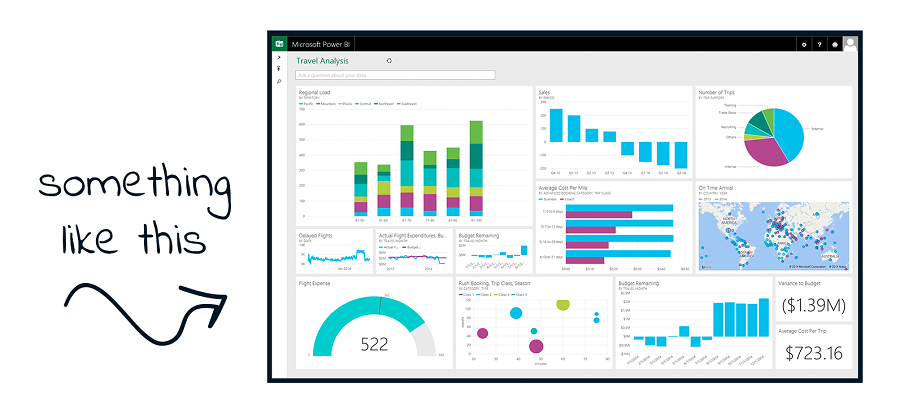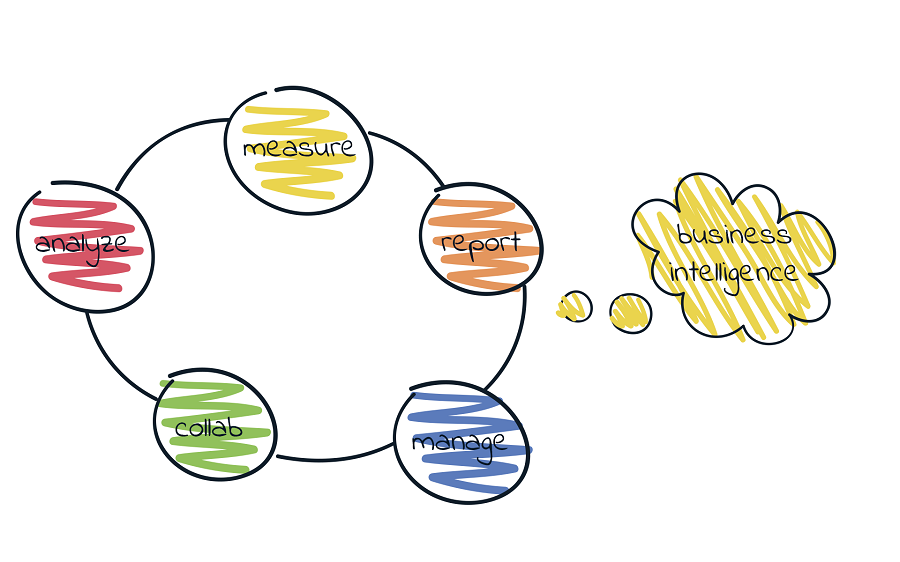Introduction
BI, BA, big data, machine learning, the blockchain, cloud technologies, etc.… lots of unfamiliar terms keep popping out of nowhere confusing business owners and executives. And while there is enough information online, no one really understands what’s that all about. If you opened this article, then you are probably one of those people.
No worries, as we have taken it upon ourselves to shed some light on what is Business Intelligence, how it works, and whether you need it – so read on!
What is Business Intelligence?
When googling “business intelligence definition”, internet responds with:
“Business Intelligence, or BI for short, is a set of technologies and methodologies applied to transform raw data into valuable insights in order to proactively respond to internal and external changes.
“Okay”, you think, “seems like I get it, but I still don’t get it. Does it mean BI is something that automatically turns the data into a list of good and bad decisions to make?”
Nope, BI is a collection of computer-based methods and technologies for data processing. Meaning that Business Intelligence stands for technologies that handle massive amounts of stored data and later process it with complex algorithms to depict the information you need. They can be either fully automatic or just somehow computerized with the help of developers, analysts, managers, and other personnel.
BI is not a solution, rather it is a tool to use to make your decision-making process easier.
“Right, but what do I, an executive, get to work with?”
You end up with a Dashboard that depicts the chosen aggregates of data in a comprehensive way (spreadsheets, pie charts, tables and graphs, etc.)

The BI-powered dashboard allows you to select multiple data sources (internal or external, or both) and shape the data to meet your business needs, e.g., connecting several data sources, changing the way data is represented, etc. for further analysis and report-making to:
- make data-driven business decisions,
- keep an eye on the current state of business,
- quickly react to any market shifts,
- discover new business opportunities,
- gain competitive advantage in the market,
- spot unresolved business problems
And so much more depending on the kind and the amount of data you want to look through.
How does Business Intelligence work?
Let’s pretend you run several restaurants across the state. As the client comes inside and sits at the table, the BI system marks this process and begins to accumulate all the incoming data connected to the process (the time they spend inside, the average number of people behind the table, the average number of dishes ordered, busy and silent hours, define visitor personas), and much more.
It allows you to gather raw data during business operations at one place so it could be further used to provide a precise outlook on the current business state.
Basically, Business Intelligence changes the approach to the data that you had before (manual processing with poor or no analysis). Once the data is processed, the output helps understand and predict future industry trends, figure out the efficiency of established processes, and learn from industry’s metrics and best practices.
What’s the purpose of Business intelligence?
The sequence of processes and the overall goal of the business intelligence can be described by the acronym MARCKM that stands for measurement, analytics, reporting, collaboration, and knowledge management.
Measurement: manages over the set metrics to measure the efficiency of the business (time spent in the restaurant, average number of visitors, average sum of money spent, etc.), benchmark (compare your metrics and success index to those of your main competitors), and evaluate the performance of the business based on the results.
Analytics: the data collected from different branches of business, e.g., the kitchen, the restaurant hall, the bar, the host, etc. gets organized and standardized so it could be delivered in a comprehensive form for further business analysis.
Reporting: generates reports based on received organized data, including its visualization for easier understanding.
Collaboration: instead of exchanging the register books between the kitchen, the restaurant hall and the bar, all information would be put into one computerized book simultaneously. It allows seeing a whole picture of the current state of the business.
Knowledge Management is the quintessence of the BI. it’s when you start applying the results received from analyzing data to optimize existing business processes e.g., offering special meal discounts based on the busy hours and the most preferred dishes, putting up lunches for delivery, launching a loyalty program, etc.
All-in-all, the main purpose of the BI is to ease the life of the business owner and company’s executives with the valuable information that provides them a steady backbone for data-driven decision making, and offers to look at the past, current, and possible future state of the business that can change in real-time as information in the database updates.

What components does Business Intelligence consist of?
Usually, we hear people talking about BI like some sort of a separate giant machine with super-duper software. However, while Business Intelligence can be offered in a from of a special independent software product with a set of tools, it can also be implemented as a part of any Business management software that collects and analyzes data (CRM, BDMS, ERP etc.).
The most noteworthy components of BI are:
- Data Warehousing.Data warehousing is probably one of the most significant parts of the BI that answers for collecting all kind of data available and storing it. This way later if you decide to have a report on something extraordinary new like “how many times your visitors have ordered chocolate pudding” there will be information about it for the whole period of time starting the day the system was implemented.
- Online Analytical Processing (OLAP).OLAP is responsible for the fast processing of the chosen categories of data and its analysis. In short, you have selected the type of information you need from the data storage, and OLAP makes it possible to sort out, select and filter what you need, e.g., the time when visitors order chocolate pudding at, at what restaurants they order chocolate pudding the most and so on.
- Real-time Business Intelligence. With real-time updates of information concerning internal and external changes in customer demands, business can quickly follow and respond to trend shifts. The real-time feature gives the opportunity to launch or dismiss special offers immediately, and create one-time specials like putting up hot marshmallow cocoa on sale on a snowy day, or putting up knitted covers when the season is exceptionally cold to attract more clients.
- Corporate Performance Management (CPM).This component offers an outlook on the parameters of products and services that your business provides. This way you can look after not only the quality of the output materials but also on the overall performance of your employers individually, as well as collectively (e.g., as a whole restaurant).
Who can use Business intelligence?
Any business that wants to see the whole picture, has set goals, and wants to know what kind of decisions to make to reach them as soon as possible. Basically, the better you’d know your business, the better choices you are going to make regarding its performance and progress.
How and when to integrate BI?
As we mentioned already, Business Intelligence system is not a single-software product only. It is a type of solution that can be implemented in any kind of business management system. We recommend not letting the term haunt you. The BI is, first of all, accurate usage of collected information.
If answering the question about “when to implement BI?”, our answer is ‘whenever you find necessary”. There is no single correct answer on this one. Of course, the sooner the better. However, no need beating yourself up if that’s not the first thing you think about.
Next, how to integrate BI?
- You can choose to work with a service provider that offers SAAS (system as a service) Business intelligence solution. It’d be useful in the case you do not think that complete business automation is something you want right now. Or if you want to entrust this side of business to an outsource advising company.
- You can develop a personal BI-like software to suit the purposes of your business. Saying BI-like, I mean that implementing the same variety of tools as a ready-made Bi solution would be quite the challenge.
- You can add a couple of necessary BI tools into a custom management software developed to suit your business. Together with managing and analyzing data for business purposes, it will also allow you to control all aspects of business from the same Dashboard menu.
Summary
Business intelligence is a tool kit for helping business owners use data in meaningful and productive ways. Today by developing and utilizing various BI tools, companies gain insights that allow them to respond to market changes and other external factors proactively. Despite the fact that more and more businesses continuously collect enormous amounts of raw data, a few actually exploit the power of that data to gain insights and implement changes.
While BI provides methodologies and tools to develop proper software utilities that shall help businesses efficiently change and make fact-based decisions with a more holistic view of their actual growth potential, it is not the complete solution that can suit any type of business.
If you keep thinking about Business Intelligence solutions in your business, give us a call. Whether you need a separate BI software, a new business management system or to put up aspects of BI into your existing business model, we will be able to work it out together and provide you with technical assistance!
Our team would be pleased to help you out – just drop us a note!



